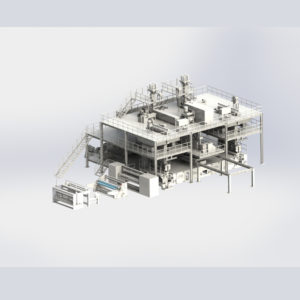An SMS (Spunbond-Meltblown-Spunbond) nonwoven machine is a type of nonwoven fabric manufacturing machine that produces a three-layered nonwoven fabric. The SMS nonwoven fabric is made by combining spunbond and meltblown technologies to create a material that has enhanced properties such as strength, durability, and liquid resistance.
Here are some features and benefits of an SMS nonwoven machine:
High quality nonwoven fabric: An SMS nonwoven machine produces high-quality nonwoven fabric that is suitable for a wide range of applications, including medical and hygiene products, protective clothing, and filtration materials.
Three-layered fabric: The SMS nonwoven fabric is made up of three layers – a spunbond layer on the top and bottom, and a meltblown layer in the middle. This three-layered structure provides enhanced strength, durability, and liquid resistance.
Versatile: An SMS nonwoven machine is versatile and can produce a wide range of nonwoven fabrics with different weights, widths, and colors to meet different customer needs.
High production capacity: An SMS nonwoven machine has a high production capacity, which can meet the demands of large-scale manufacturing operations.
Efficient: An SMS nonwoven machine is an efficient way to produce nonwoven fabrics. It can produce high-quality fabrics with minimal waste and energy consumption.
Easy to operate: An SMS nonwoven machine is easy to operate and requires minimal training. It is equipped with a user-friendly interface that allows operators to control the machine and monitor the production process.
Low maintenance: An SMS nonwoven machine requires minimal maintenance, which helps to reduce downtime and increase productivity.
Overall, an SMS nonwoven machine is a reliable and efficient way to produce high-quality nonwoven fabrics with enhanced properties. sms nonwoven machine When choosing an SMS nonwoven machine, it’s important to work with a reputable supplier who can provide quality machines and installation services. Regular maintenance and testing can ensure that the machine is functioning correctly and ready to use in case of a production emergency.
To ensure that an SMS nonwoven machine functions correctly and produces high-quality nonwoven fabrics, regular maintenance is required.
Here are some maintenance requirements for an SMS nonwoven machine:
Daily maintenance: Clean the machine daily to remove any debris or dust that may have accumulated on the machine during production. This includes cleaning the air filters, the rollers, and the belts.
Weekly maintenance: Conduct a weekly inspection of the machine to identify any wear and tear on the components. Check for any leaks or loose connections on the hydraulic and pneumatic systems. Also, check the temperature and pressure gauges to ensure they are functioning correctly.
Monthly maintenance: Conduct a monthly inspection of the machine to check for any worn-out parts that may need to be replaced. This includes checking the belts, bearings, and rollers for any signs of wear and tear. Also, inspect the heating and cooling systems to ensure they are functioning correctly.
Annual maintenance: Conduct an annual maintenance checkup of the machine to ensure that it is functioning correctly and to identify any issues that need to be addressed. This includes checking the electrical systems, lubricating the moving parts, and replacing any worn-out parts.
Calibration: Calibrate the machine periodically to ensure that it is operating at the correct speed and temperature. This will help to ensure that the nonwoven fabric produced is of high quality and meets the required specifications.
Training: Train the operators on how to properly operate and maintain the machine. This will help to ensure that the machine is operated correctly and that any issues are identified and addressed promptly.
By following these maintenance requirements, an SMS nonwoven machine can produce high-quality nonwoven fabrics consistently and efficiently. Regular maintenance can also help to extend the lifespan of the machine and reduce downtime caused by breakdowns.
